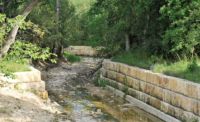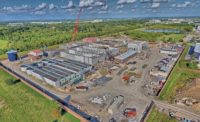The LPV-9.2 project constructed a continuous line of hurricane flood protections across reinforced and extended discharge basins at Jefferson Parish Pumping Stations No. 1 through 4, plus modifications to two existing breakwaters at Stations No. 2 and 3.

The pump stations and breakwaters play a key role in New Orleans because they link the network of drainage canals in the city. However, these stations operate 24/7, so pumping could not be shut down during construction. At any time, if necessary, the construction area would be flooded, so the pumps could start pushing water from the canals into the lake. The team had to be ready to evacuate people, equipment and materials within a 15-minute window. There were 53 instances when it rained during construction, and during each of those, the team had to completely and safely demobilize all equipment and personnel from the worksite so that the active pumping station could operate.
Given this challenge and compliance with technical requirements, the team built a unique system of temporary cofferdams that contain valves and mini-spillways. These structures allowed the work areas to dry out. The valves were automated so that plant operators could control them remotely.
Significant pile driving, concrete and mechanical work took place in a temporarily dewatered area located immediately in front of the pumping stations' discharge.
As the 2011 hurricane season approached, the client recognized the need for complex and critical design changes. Without an agreed price or schedule for the change work, the project team immediately went into action and completed the vital work, which enabled the Corps to complete the 100-year level of protection before the hurricane season.
Key Players
General Contractor Odebrecht USA, New Orleans
Owner/Lead Design U.S. Army Corps of Engineers, New Orleans



